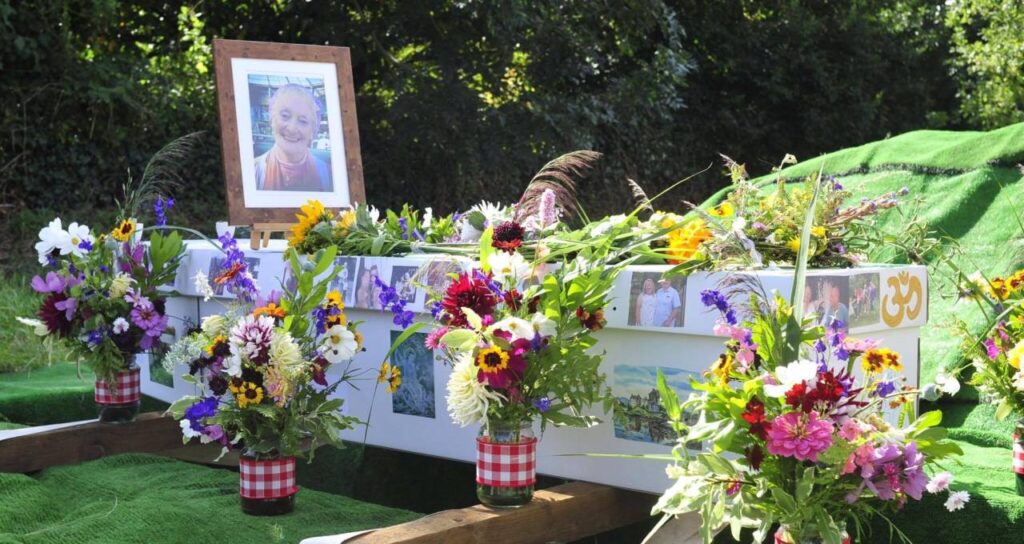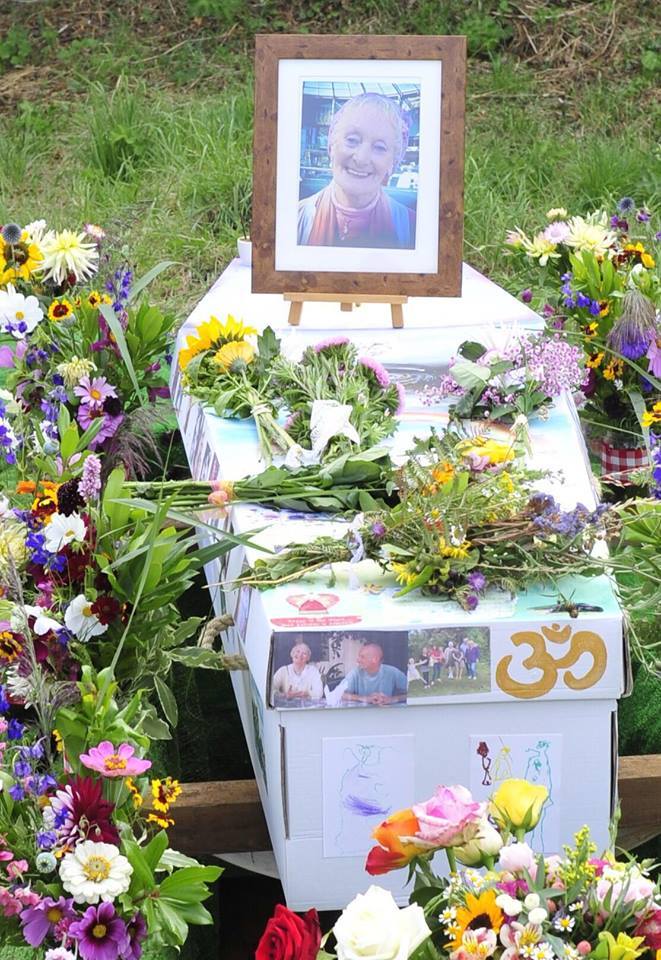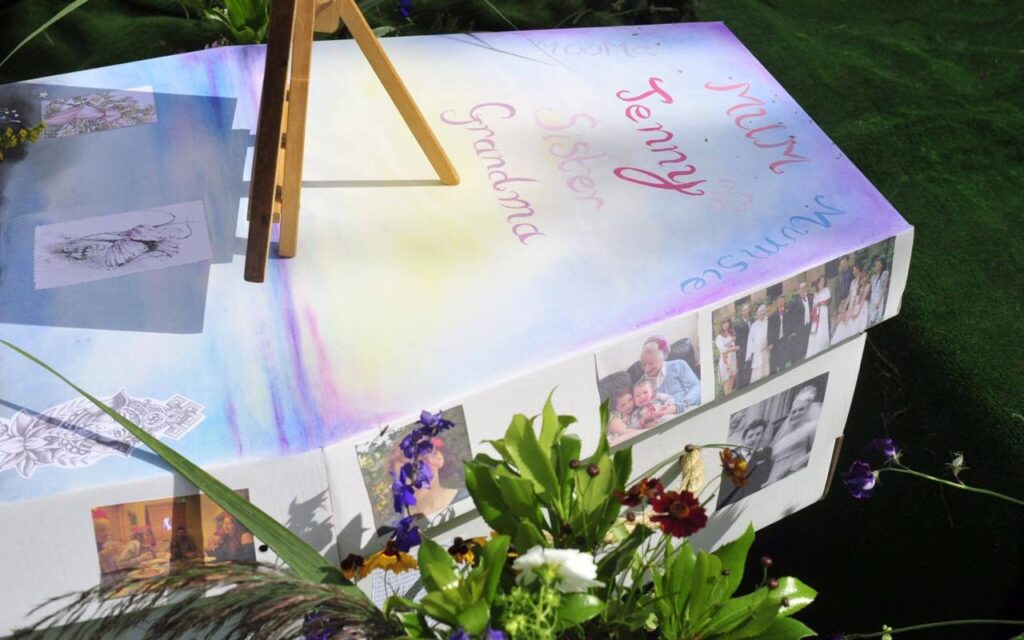
From time to time, we publish guest blogs, and today we are delighted to share this beautiful account by Kirsty O’Leary-Leeson who writes movingly about her personal experience organising a funeral for her mum.
“I am writing this because we shouldn’t be scared of organising funerals; we all go away in the end. I believe that a DIY or Direct it Yourself burial is far simpler than people think and should be encouraged where possible. It wasn’t emotionally easy, but then the death of a loved one never shall be, but I am extraordinarily proud of what my brother and I did for our mum.
In July 2016 my mum was diagnosed with an incurable form of cancer called Multiple Myeloma. It was hoped that with chemotherapy she would have a bit more time. It was not to be and in the early hours of 18th August 2016, my beautiful mum passed away, myself and my brother Simon with her.
Mum had discussed with me whether to buy a burial plot a couple of years before and I had just laughed and told her to save the money, after all, what if she was lost at sea or blew up in a tragic plane accident, and there was no body to bury! She had worried about the cost of a funeral, and we had laughingly reassured her that we would just shove her in the back of our people carrier and wouldn’t spend a lot.
As a family we were not scared of discussing death, and approached it with a sense of humour. This helped my brother and I when it came to having to organising an unplanned funeral, as Mum had actually left her body to medical science, not really because science meant a lot to her but so that her small, but hard-earned savings could go to her family and not into burying a body. However, because of the chemo, mum’s body could not be accepted by our local teaching hospital.
Mum was a bit of a hippy, very spiritual but not religious and we knew she had looked into a green burial site called Nar Valley, in Pentney Kings Lynn, about an hour’s drive away from us. We went and had a look, and it was a peaceful meadow abutting the graveyard of the local church, and we decided that it would be a nice place for mum to lay her bones.
I had looked into funerals and was shocked at how expensive it all was, particularly how much funeral directors charged and for what? We obviously had to pay for the burial site, but we could save almost £300 by digging the grave ourselves, however we decided that probably by the time we got up to our knees we would be seriously regretting it and decided instead to pay the charge. We booked it for 31st August, mum’s birthday and two days before her eldest grandaughter left to go travelling in Australia. This didn’t give us much time.
I bought a white cardboard coffin from Ebay, several hundred pounds cheaper than from any website. (It came through the post in another large cardboard box and it said what it was on the outside – must have given the local courier service something to discuss). I am an artist and I began to decorate it in pastel landscapes. I also printed lots of photos of the family and glued them around the edges, plus I asked family and friends to send me cards and poems that were also added. It looked beautiful.
Whilst preparing all this mum’s body remained at the hospital mortuary, this is fine with the hospital and doesn’t cost anything, my brother simply phoned them to organise the day and time of collection and they were happy to wrap/clothe her and put her in the coffin. You just need to take the death certificate with you, and it is considered polite to offer the staff a small thankyou gift. We decided to transport mum from the mortuary to the burial site in a beautiful VW camper van. Mum was a real gypsy at heart and there was no way I was going to put her in a depressing black hearse. I found a local chap on gumtree who hired one out for celebrations and he was very understanding and helpful. My brother collected it the night before, came over to me and picked up the coffin, then the day of the funeral he drove it to the mortuary, picked mum up and drove her to Pentney. The camper van was perfect because the back opened up and the coffin could be easily slid in and out. The curtains could also be pulled closed whilst driving, as apparently you can drive a dead body around quite legally but it shouldn’t be on show. The van had bunting and flowers decorating it, and music could be played on the sound system, so it was very jolly.
At the burial site the camper van drove up close to the grave and family members moved the coffin from the van. It was placed on wooden batons that went over the grave.
Garden chairs were put out at the burial site, and there were no formal flower tributes, I had sent out a request for garden and wild flower posies instead. We were blessed by beautiful weather and the flowers were placed in decorated jars which attracted butterflies.
People began to arrive, and time was spent looking at all the pictures and photos on the coffin. When everyone had arrived we began our little service. I had contacted all the family members, and they could either say something themselves on the day, or send me a poem or some words that they would like to have read out on their behalf. I typed these up into an order of service for my husband Jamie and my sister in law’s father, Trevor, who were both officiating. They read out the welcome that my brother wrote, we had a couple of minutes silence and then I read out my own tribute – I struggled a bit but it meant a lot to do it myself (that’s why I put myself first). Then my brother read out his chosen poem, Jamie and Trevor took it in turns to read out the rest of the poems. My daughter Adara attempted to read hers, but she only got a short way through, so another family member took over, because it was quite informal and relaxed this happened quite naturally. There were no strict timings like you have at churches or crematoriums, we did everything in our own time.
At the end we played a song she had mentioned to my sister in law that she would like, Queen’s ‘Don’t Stop Me Now’ we all laughed and jigged around a bit, and just as it finished four jets flew over in formation, another two had flown over just as we started the service – ok so I can’t promise that this will happen if you DIY a funeral but everything about the day was beautiful and wonderful and although there was sadness and tears I can only think of mum’s burial as a lovely thing.
We decided not to lower the coffin ourselves, we didn’t want to risk it turning into a 70′s BBC farce, we weren’t going to do the throwing in the dirt thing anyway and we thought it would be difficult for the children to see, and so we left the coffin where it was. The lady who owned the burial site had arranged for it to be lowered and filled in within 15 mins or so of our leaving.
We all went off and had a picnic, no getting maudlin at a pub, instead it was fizzy drinks, cups of tea and vegetarian sausage rolls. It was a beautiful day for a beautiful soul.
Over 7 years later, friends and family still talk about it being the most wonderful send-off. Far less of an endurance task than a formal funeral where you are told where to go and what to do and which I have found to be very stressful. It was great not to have any strangers involved, no matter how nice funeral director’s staff are, they are simply doing a job.
I personally have asked to have a ‘direct to cremation’ so no coffins just a celebration at the point of scattering the ashes, however, if any of my four children feel the need to take my body to the crematorium in a decorated cardboard coffin at least they know how to do it.”
Kirsty O-Leary-Leeson


